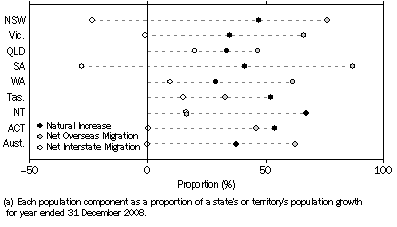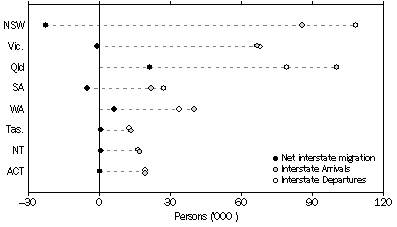MAIN FEATURES
POPULATION AND GROWTH
The preliminary estimated resident population (ERP) of Australia at 31 December 2008 was 21,644,000 persons, an increase of 406,100 since 31 December 2007 and 101,500 persons since 30 September 2008. The increase for the year ended 31 December 2008 is the largest recorded for a 12 month period since the ERP concept was introduced in 1971 (see paragraphs 4 to 6 of the Explanatory Notes for more detail on ERP).
The annual population growth rate for the year ended 31 December 2008, at 1.91% was the fastest annual growth rate for a year ended 31 December since the ERP concept was introduced in 1971.
COMPONENTS OF POPULATION CHANGE
The growth of Australia's population has two components: natural increase (the number of births minus the number of deaths) and net overseas migration.
Natural Increase
Natural increase for the 12 months ended 31 December 2008 was 152,700 persons, an increase of 3.1% (or 4,600 persons) on the natural increase for the year ended 31 December 2007 (148,100 persons).
BIRTHS
The preliminary estimate for births during the year ended 31 December 2008 (296,610) was 3.3% higher than the figure for the year ended 31 December 2007 (287,000).
DEATHS
The preliminary estimate for deaths during the year ended 31 December 2008 (143,900) was the highest ever recorded for a year ending 31 December.
Net Overseas Migration
For the year ended 31 December 2008, Australia's preliminary net overseas migration (NOM) estimate was 253,400 persons. This was the difference between 483,600 overseas arrivals that were added to the population (NOM arrivals) and 230,200 overseas departures that were subtracted from the population (NOM departures). The contribution made to population growth by NOM (62.4%) was higher than that of natural increase (37.6%).
STATES AND TERRITORIES: POPULATION AND GROWTH
The estimated resident populations for the states and territories at 31 December 2008 were as follows: New South Wales 7,041,400, Victoria 5,364,800, Queensland 4,349,500, South Australia 1,612,000, Western Australia 2,204,000, Tasmania 500,300, the Northern Territory 221,700 and the Australian Capital Territory 347,800.
All states and territories recorded positive population growth over the 12 months ended 31 December 2008. Western Australia recorded the fastest growth rate (3.1%), followed by Queensland (2.5%), the Northern Territory (2.0%), Victoria (1.9%), the Australian Capital Territory (1.7%), New South Wales (1.4%), South Australia (1.2%) and Tasmania (1.0%).
COMPONENTS OF POPULATION CHANGE
At the state and territory level, population growth has three components: natural increase, net overseas migration and net interstate migration.
Although all states and territories experienced positive population growth in the year ended 31 December 2008, the proportion that each of these components contributed to population growth varied between the states and territories.
Population Components as a proportion of total growth(a) - Year ended 31 December 2008

Natural Increase
As illustrated in the graph above, natural increase was the major component of population growth in the Northern Territory at 67.1% (2,850 persons), the Australian Capital Territory at 53.9% (3,100 persons) and Tasmania at 52.1% (2,560 persons) for the year ended 31 December 2008.
BIRTHS
The number of births registered for the 12 months ended 31 December 2008 increased in comparison with the previous year, in all states and territories except Victoria. Western Australia recorded the largest percentage increase of 8.9%, followed by New South Wales (4.8%).
DEATHS
The number of deaths registered for the 12 months ended 31 December 2008 increased in comparison with the previous year, in all states and territories. The Australian Capital Territory recorded the largest percentage increase of 8.0%, followed by Queensland (7.0%).
Net Overseas Migration
The contribution of NOM, as illustrated in the previous graph, was the major component of population growth in South Australia at 86.9% (16,100 persons) for the year ended 31 December 2008, followed by New South Wales at 76.2% (74,300 persons). This was followed by Victoria at 66.2% (67,800 persons), Western Australia at 61.6% (40,600 persons) and Queensland at 46.6% (49,700). The other states and territories also experienced positive net overseas migration.
Net Interstate Migration
For the year ended 31 December 2008, Queensland experienced the highest positive net interstate migration with a gain of 21,200 persons. Other states and territories that experienced positive net interstate migration were Western Australia (6,300 persons), Tasmania (730) persons, the Northern Territory (690 persons) and the Australian Capital Territory (11 persons). Negative net interstate migration was experienced by New South Wales (-22,700 persons), South Australia (-5,200 persons), and Victoria (-1,000 persons).
Interstate migration, Arrivals, Departures and Net
- States and territories
- Year ended 31 December 2008

 Print Page
Print Page
 Print All
Print All
 Quality Declaration
Quality Declaration